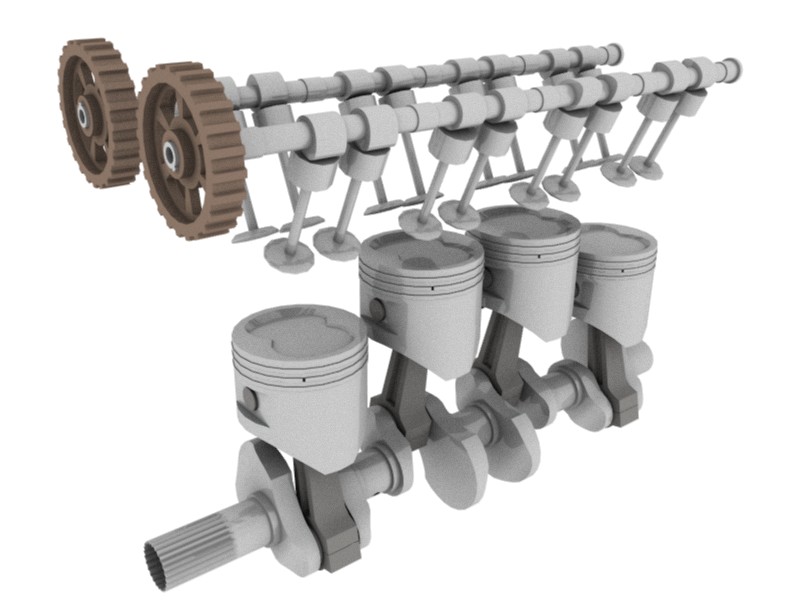UNSW scientists have proposed using dual-fuel piston engines to add gas-to-power operations in large-scale hydrogen production from PV energy. Preliminary findings from their research show that the proposed system still achieves too high an LCOE for commercial maturity. However, falling electrolyser costs, policy interventions and changing energy market dynamics could more than halve LCOE values in the future.
A group of scientists from the University of New South Wales in Australia have investigated the technical and economic feasibility of relying on hydrogen-powered piston engines to use PV-powered hydrogen in both gas-to-power and power-to-gas operations.
Reciprocating engines are engines that use one or more pistons to convert pressure into rotational motion. They convert the heat and pressure released during the combustion of a fuel mixed with air into mechanical energy.
The proposed solution is designed to reduce the levelized energy cost (LCOE) of hydrogen generation powered by large-scale PV. “The cost of a piston engine is not expected to decrease in the future because it is a relatively mature technology,” Shaun Chan, the study’s lead author, said. pv magazine. “The feasibility of the proposed configuration will depend on the cost of the electrolyzer.”
In the study “Evaluation of the techno-economic feasibility of hydrogen-powered piston engines for renewable baseload energy generation,” published in Energy conversion and managementAccording to the research group, the system includes a large-scale PV plant of 180 MW, a proton exchange membrane (PEM) electrolyzer of 93 MW, a compressor of 4 MW and a pressurized hydrogen storage unit of 29 tons for the conversion of energy to gas. as well as a 10 MW hydrogen-powered piston generator based on hydrogen-diesel double direct injection (H2DDI) technology for gas-to-power operation.
The power-to-gas storage unit works with the excess power provided by the solar farm, while the gas-to-power unit is used to convert the stored hydrogen into electricity when there is limited availability of electricity in the market. “The hydrogen produced can be sold on the market and blended into the existing natural gas pipeline, or stored for later use when power generation from the PV is insufficient, such as at night or during adverse weather conditions,” the scientists explained.
Image: UNSW, Energy Conversion and Management, Creative Commons License CC BY 4.0
The researchers specified that diesel is used both as an ignition source and as an additional energy source, with the H2DDI technology can measure variable amounts of hydrogen and diesel to produce power based on available fuel reserves. They also explained that an increase in hydrogen energy fraction resulted in a higher LCOE.
The techno-economic analysis showed that the proposed system configuration has the potential to achieve an LCOE of $335.52/MWh and minimum CO2 emissions of 78 kg/MWh. By comparison, New South Wales’ current average LCOE is half this value. The system was also shown to improve sustainable grid supply by increasing diesel consumption without a substantial increase in LCOE.
Although these initial findings indicate that the proposed technology still has a long way to go before it reaches commercial maturity, the research team is confident that the system’s adaptability will ensure it becomes competitive with alternative technological approaches.
With this in mind, the academics carried out a series of technical and economic assessments, taking into account expected energy prices, possible policy improvements, technological advances and network improvements. Through this analysis, they found that the system can achieve optimized LCOE values of $138.76/MWh and $148.91/MWh for the engine and PEM fuel cell systems, respectively.
“Sensitivity analysis revealed that the LCOE was most sensitive to the discount rate, with a 2% variation leads to a 27%-30% change,” they further explained. “Other way around, Fluctuations of 5% in trading prices for diesel fuel, hydrogen wholesale and large-scale generation certificates (LGC) had minimal impact due to the optimized and unchanged system size within the tested ranges.”
They also specified that the described landscape could be significantly changed in the future by breakthroughs in renewable energy and energy storage technologies. “The economic viability of the technology could be significantly affected by future government policies and regulations related to carbon pricing mechanisms, renewable energy targets and clean technology support programs,” she added.
This content is copyrighted and may not be reused. If you would like to collaborate with us and reuse some of our content, please contact: editors@pv-magazine.com.

